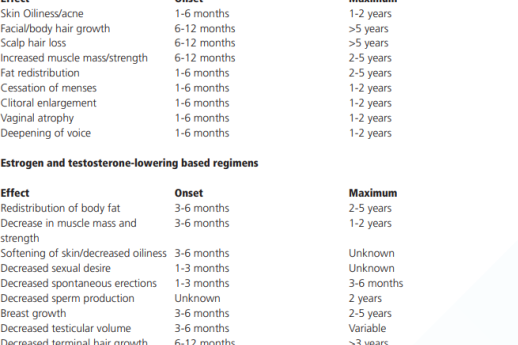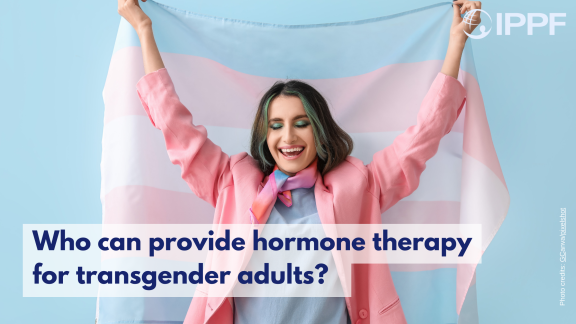Gender-affirming care for transgender people
Transgender people are diverse in their need for gender transition‑related services; not all transgender people want to affirm their bodies through gender-affirming medical procedures. Procedures include gender-affirming hormone therapy (GAHT); gender-affirming surgery (GAS) – procedures of the face, breast, chest, body, or genitals; and facial hair removal and voice and communication therapy. WPATH recommends that healthcare systems should provide medically necessary gender-affirming health care for transgender people.
According to the medical necessity statement issued by the World Professional Association for Transgender Health (WPATH): “Sex reassignment plays an undisputed role in contributing toward favourable outcomes, and comprises real life experience, legal name and sex change on identity documents, as well as medically necessary hormone treatment, counselling, psychotherapy, and other medical procedures.”
For many transgender people, hormone therapy is part of the affirmation of their gender identity, so providing this service may assist them to realize their sexual and gender rights.
when
Subject
LGBTI+

Sex reassignment plays an undisputed role in contributing toward favourable outcomes, and comprises real life experience, legal name and sex change on identity documents, as well as medically necessary hormone treatment, counselling, psychotherapy, and other medical procedures. (World Professional Association for Transgender Health)

Who can provide hormone therapy for transgender adults?
Worldwide, physicians from different specialties offer hormone therapy for transgender adults, including endocrinology, family medicine, primary care, internal medicine, obstetrics and gynecology, and psychiatry. The WPATH’s Global Education Institute offers training in GAHT.
Depending on comfort level and experience, primary care providers may initiate hormone therapy or maintain hormone therapy started by an endocrinologist or other experienced physician; at a minimum, they should be able to provide information on hormone therapy and referrals to health care professionals who are experienced in providing hormone therapy. Primary care providers may already have experience in the use of estrogens (for contraception and estrogen replacement in post‑menopausal women), testosterone (for hypogonadism and androgen‑deficient states), and testosterone‑blocking medications (for hirsutism and prostatic disease). This knowledge and experience can be used to initiate and maintain hormone therapy among transgender clients who do not have co‑morbid conditions.
The goal of GAHT is to align the body’s external appearance with the experienced gender. In addition to physical changes, psychological benefits occur in the form of improved quality of life, regardless of whether they have undergone GAS, as being on GAHT can help affirm gender identity.
Current standards of care for gender-affirming hormone therapy (GAHT) for transgender adults
For a clinician, a practical target for hormone therapy for testosterone is to increase and maintain the testosterone blood levels to the normal range for a biological male (300–1000 ng/dl) by administering testosterone in similar doses as is used for treatment of hypogonadism (injections, tablets, or skin patches). Similarly, a practical target for hormone therapy for estrogen is to decrease and maintain testosterone levels to 30–100 ng/dl) without supraphysiological levels of estradiol (<200 pg/ml). This is achieved by administering estrogens similar to that in post-surgical menopause (under 50) and in menopause (over 50) and providing anti‑androgens (e.g. spironolactone, cyproterone acetate).
In general, hormones are initiated at a low dose and gradually increased to achieve the desired physical effects and/or testosterone levels. Once the maximal physical impact is reached (usually two to three years), a maintenance dose is used. Dosage is also adjusted according to age and associated health conditions (for example, hypertension and diabetes). After surgical removal of gonads, hormone replacement with estrogen or testosterone is life-long and needs to be adapted to the individual.
Self‑administration of hormones among transgender people is quite common. Often it is due to the lack of trans‑competent qualified health professionals or unwillingness among health professionals to prescribe hormones to transgender people. Fear of litigation is a concern in some settings. Therefore, clinicians must take a history of previous and current self‑administration of hormones before prescribing hormone therapy. Information on the type and dosage of self‑administered hormone tablets or injections is primarily gained through peer networks or the internet, both of which can be fallible. Even if the information they receive is correct, transgender people may take higher and/or more frequent doses to speed up their feminization or masculinization process. Unsupervised hormone use can adversely affect the functioning of the liver or heart and increase the risk of thromboembolism. The chances of adverse effects are higher if there is associated problematic alcohol use.
Transgender people must receive accurate and comprehensive information about the benefits and risks of hormone therapy, including information on reversible and permanent physical effects. Informed consent is fundamental for the provision of GAHT. It is good practice to provide a written consent form that sets out the risks and benefits of the treatment before it is initiated. As long‑term GAHT affects fertility (the ability to produce viable sperm or ova), WPATH recommends that decisions about fertility always be discussed with the client. For example, they can be informed about sperm banking, oocyte (egg), or embryo freezing.

Expected time course of physical changes in response to hormone therapy (estrogens or testosterone)
IMAP Statement on Hormone Therapy for Transgender and Gender Diverse PersonsWhat is puberty suppression?
Puberty suppression prevents the development of secondary sexual characteristics of the gender assigned to them at birth. Before beginning puberty suppression, a mental health professional should diagnose and confirm that the person has gender dysphoria; the initiation of puberty suppression, usually using gonadotropin analogues (GnRH agonist analogues), needs to be managed by an endocrinologist. GnRH agonist analogues have been shown to be safe, and puberty can resume as usual once they are stopped. If the decision is made to start hormone therapy, this would be possible once the GnRH treatment has been discontinued.
The WPATH Standards of Care guidelines (version 7) specify the following minimum criteria for puberty suppression treatment:
1) the adolescent has demonstrated a long‑lasting and intense pattern of gender non‑conformity or dysphoria;
2) gender dysphoria emerged or worsened with the onset of puberty;
3) any coexisting psychological, medical or social problems that could interfere with treatment have been addressed; and
4) the adolescent or parents/carers have given informed consent (depending on the legal age of medical consent) while supporting the adolescent throughout the treatment.











